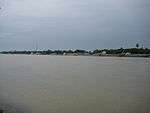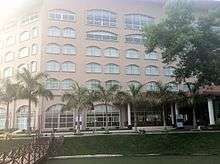Economy of Sylhet
The economy of Sylhet Division is the third largest in People's Republic of Bangladesh. The province is known as the Agricultural Capital of Bangladesh due to vast natural resources. Sylhet is also seen as the future economic engine of Bangladesh due to its vast economic prospects. The province is home to the world's largest tea plantations, both in terms of area and production. However, the Province is more known for its business boom and investment in luxurious hotel, and real estate. The hinterland of the Sylhet valley is the largest oil and gas-producing region in Bangladesh. It is also the largest hub of tea production in Bangladesh. It is notable for its high-quality cane and agarwood.[2][3]
 The Location of Sylhet on the Map of Bangladesh | |
| Statistics | |
|---|---|
Population below poverty line | 24.1%[1] |
| Unemployment | 7.80% (2010) |
Economy
Sylhet region is the most enriched area of Bangladesh. A vast quantity of proven gas reserve and Bangladesh's only oil field in located in the region.
Natural Gas
Sylhet contains a vast amount of proven natural gas reserve. There are total eight gas fields located in the region. Total reserve of gas fields of the region is about 14 trillion cubit feet. According to Jalalabad Gas System Limited, The company's annual revenue earning is around 5.66 billion.
Remittance

Remittance is one of the biggest source behind Sylhetis economic growth. Many Sylhetis that live abroad live in many countries, notably countries in the Middle East such as Saudi Arabia, the United Arab Emirates, etc., France, the United States, and the United Kingdom. Many remittances are sent from the United Kingdom to Sylhet unlike many other countries as the majority, believed to be around 90-95%, of the British Bangladeshi population claim they are from Sylhet. The remittance of financial year 2012–13 is estimated around $10 billion. Numerous projects and businesses in the city and in large towns have been funded by Sylhetis living and working abroad. As of 1986, an estimated 95 percent of the ethnic British Bangladeshis originated from or had ancestors from the Sylhet region.[4] The city receives a significant portion of the country's annual remittances, which have driven growth in real estate and construction.[5] A number of shopping centres, restaurants and hotels have opened as a result.
Tourism

Sylhet is one of the most popular tourist destinations in Bangladesh. The province offers tourists with variety of options ranging from natural to commercial. The province is home to some of the most luxurious Hotels, Resorts and Shopping Malls in Bangladesh. Sylhet also relies on religious tourism, with thousands of devotees visiting its Sufi shrines annually, as well as ecotourism in its broader natural hinterland. Nature resorts have been built in the city's outskirts.
Fisheries
A large portion of fishes in Bangladesh comes from rivers and Haor region, among them Hakaluki Haor, Tanguar Haor including many more rivers in Sylhet meet the demand of fishes in this region.
Tanguar haor
Tanguar haor plays an important role in fish production as it functions as a 'mother fishery' for the country.[6][7] It is the source of livelihood for more than 40,000 people.[6]
Every winter the haor is home to about 200 types of migratory birds. The haor is an important source of fish. In 1999–2000, the government earned 7,073,184 takas as revenue just from fisheries of the haor. There are more than 140 species of fresh water fish in the haor. The more predominant among them are: ayir, gang magur, baim, tara, gutum, gulsha, tengra, titna, garia, beti, kakia etc.[7]
Tea industry
The area around Sylhet is a traditional tea growing area. The Surma Valley is covered with terraces of tea gardens and tropical forests. Srimangal is known as the tea capital of Bangladesh; for miles around, tea gardens are visible on the hill slopes. As a result, Bangladesh Tea Research Institute (BTRI) is an autonomous organisation under the Bangladesh Tea Board (BTB).[8][9][10] have been established here. Today, Bangladesh has 172 commercial tea estates, including many of the world's largest working plantations.[11][12] Among which, Sylhet has over 150 tea gardens, including three of the largest tea plantations in the world, both in terms of area and production. The area Nearly 300,000 workers, of which more than 75% are women, are employed on the tea estates. The industry accounts for 3% of global tea production, and employs more than 4 million people.[13]
Tea is the second largest export oriented cash crop of Bangladesh, following jute. The industry accounts for 1% of national GDP.[14] Including Maulvi Bazar, Habiganj, Sylhet, this area has three Tea-producing districts.
References
- "Zila level povmap estimates, 2010" (PDF). Bangladesh Bureau of Statistics. Retrieved 27 June 2017.
- https://global.britannica.com/place/Sylhet%5B%5D
- Siddiquee, Iqbal (19 October 2011). "Agar farming sees export markets". The Daily Star.
- Gardner, Katy (July 1992). "International migration and the rural context in Sylhet". New Community. 18 (4): 579–590. doi:10.1080/1369183X.1992.9976331.
- "'Londonis' build big in Bangladesh". BBC News. 22 December 2011.
- "Tanguar Haor". Swiss Agency for Development and Cooperation. Archived from the original on 14 November 2007. Retrieved 23 November 2007.
- Talukdar, Nixon (2012). "Tanguar Haor". In Islam, Sirajul; Jamal, Ahmed A. (eds.). Banglapedia: National Encyclopedia of Bangladesh (Second ed.). Asiatic Society of Bangladesh.
- Minuddin Ahmed; AFM Badrul Alam (January 2003). "Bangladesh Tea Research Institute". In Sirajul Islam (ed.). Banglapedia. Dhaka: Asiatic Society of Bangladesh. ISBN 984-32-0576-6. Retrieved 12 May 2016.
- "Brain drain dims achievements". The Daily Star. 1 November 2012. Retrieved 18 November 2016.
- "Bangladesh tea trade gets new brew". BBC News. Retrieved 18 November 2016.
- Dr. Kazi Muzafar Ahammed. "Investment for Sustainable Development of Bangladesh Tea Industry – An Empirical Study" (PDF). Bangladesh Economic Association. Retrieved 3 April 2015.
- "Tea Gardens in Bangladesh". bangladesh.com. Retrieved 24 March 2015.
- "Tea". scribd.com. Retrieved 24 March 2015.
- "Tea @ Global Trade Concern – Bangladesh". Tea.globaltradeconcern.com. Retrieved 3 April 2015.